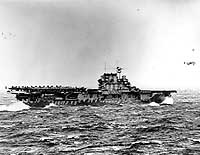
USS Hornet, a 19,800 ton Yorktown class aircraft carrier, was constructed at Newport News, Virginia. Commissioned in October 1941, she spent the next four months shaking down in the Atlantic. Transferred to the Pacific in March 1942, Hornet was immediately employed on the Doolittle raid. On 18 April 1942, she launched 16 Army B-25 bombers to attack Japan, a strike that caused relatively little damage, but which had enormous strategic implications.
Hornet was then sent to the South Pacific to reinforce U.S. units there following the Battle of Coral Sea, but was recalled to Pearl Harbor in mid-May. She then took part in the Battle of Midway, on 4-6 June, during which her planes shared in the sinking of the Japanese cruiser Mikuma.
In August 1942, Hornet returned to the South Pacific to join in the fight for Guadalcanal. During much of September and October, she was the only operational U.S. aircraft carrier available to oppose the Japanese in that area. On 26 October 1942, during the Battle of the Santa Cruz Islands, her planes attacked and badly damaged the Japanese carrier Shokaku. In return, however, Hornet received heavy bomb and torpedo damage, necessitating her abandonment. Though accompanying U.S. destroyers attempted to scuttle her, she remained afloat until torpedoed and sunk by Japanese ships early in the morning of 27 October.
This page selected views concerning USS Hornet (CV-8).
| If you want higher resolution reproductions than the digital images presented here, see: "How to Obtain Photographic Reproductions." |
Click on the small photograph to prompt a larger view of the same image.
|
Photo #: NH 81313 USS Hornet (CV-8) Photographed circa late 1941, soon after completion, probably at a U.S. east coast port. A ferry boat and "Eagle Boat" (PE) are in the background. U.S. Naval History and Heritage Command Photograph. Online Image: 99KB; 740 x 600 pixels |
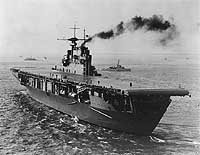 |
|
Photo #: 80-G-41197 Doolittle Raid on Japan, April 1942 USS Hornet (CV-8) launches Army Air Force B-25B bombers, at the start of the first U.S. air raid on the Japanese home islands, 18 April 1942. Official U.S. Navy Photograph, now in the collections of the U.S. National Archives. Online Image: 99KB; 740 x 600 pixels Reproductions of this image may also be available through the National Archives photographic reproduction system. |
 |
|
Photo #: 80-G-41196 Doolittle Raid on Japan, April 1942 An Army Air Force B-25B bomber takes off from USS Hornet (CV-8) at the start of the raid, 18 April 1942. Note men watching from the signal lamp platform at right. Official U.S. Navy Photograph, now in the collections of the U.S. National Archives. Online Image: 114KB; 740 x 600 pixels Reproductions of this image may also be available through the National Archives photographic reproduction system. |
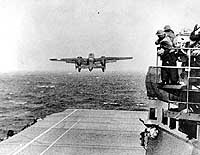 |
|
Photo #: 80-G-16865 USS Hornet (CV-8) Arrives at Pearl Harbor after the Doolittle Raid on Japan, 30 April 1942. PT-28 and PT-29 are speeding by in the foreground. Official U.S. Navy Photograph, now in the collections of the U.S. National Archives. Online Image: 63KB; 740 x 625 pixels Reproductions of this image may also be available through the National Archives photographic reproduction system. |
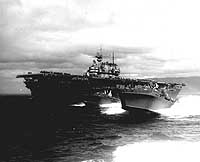 |
|
Photo #: 80-G-14866 USS Hornet (CV-8) Underway in the Southern Pacific, 15 May 1942, a week after the Battle of Coral Sea and the day before she was recalled to Pearl Harbor to prepare for the Battle of Midway. Official U.S. Navy Photograph, now in the collections of the U.S. National Archives. Online Image: 61KB; 740 x 595 pixels Reproductions of this image may also be available through the National Archives photographic reproduction system. |
 |
|
Photo #: 80-G-66132 USS Hornet (CV-8) Enters Pearl Harbor, 26 May 1942. She left two days later to take part in the Battle of Midway. Photographed from Ford Island Naval Air Station, with two aircraft towing tractors parked in the center foreground. Official U.S. Navy Photograph, now in the collections of the U.S. National Archives. Online Image: 123KB; 740 x 615 pixels Reproductions of this image may also be available through the National Archives photographic reproduction system. |
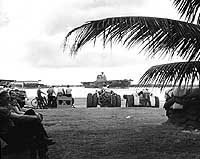 |
|
Photo #: 80-G-66129 USS Hornet (CV-8) At Pearl Harbor, 26 May 1942, just after the Battle of Coral Sea, and just before the Battle of Midway. Harbor tug Nokomis (YT-142) is underway alongside her. Note paint chipped off Hornet's waterline area by wave action while at sea. Official U.S. Navy Photograph, now in the collections of the U.S. National Archives. Online Image: 71KB; 740 x 620 pixels Reproductions of this image may also be available through the National Archives photographic reproduction system. |
 |
|
Photo #: 80-G-33947 Battle of the Santa Cruz Islands, October 1942 A Japanese Type 99 shipboard bomber (Allied codename "Val") trails smoke as it dives toward USS Hornet (CV-8), during the morning of 26 October 1942. This plane struck the ship's stack and then her flight deck. A Type 97 shipboard attack plane ("Kate") is flying over Hornet after dropping its torpedo, and another "Val" is off her bow. Note anti-aircraft shell burst between Hornet and the camera, with its fragments striking the water nearby. Official U.S. Navy Photograph, now in the collections of the U.S. National Archives. Online Image: 83KB; 740 x 610 pixels Reproductions of this image may also be available through the National Archives photographic reproduction system. |
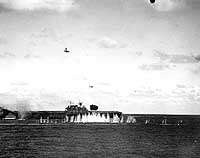 |
|
Photo #: 80-G-40300 Battle of the Santa Cruz Islands, October 1942 Damage to the smokestack and signal bridge of USS Hornet (CV-8) after it was struck by a crashing Japanese dive bomber, during the morning of 26 October 1942. Smoke at bottom is from fires started when the plane subsequently hit the flight deck. Note ship's tripod mast, with CXAM radar antenna in top left and the flag still flying above the damaged structure. Official U.S. Navy Photograph, now in the collections of the U.S. National Archives. Online Image: 104KB; 590 x 765 pixels Reproductions of this image may also be available through the National Archives photographic reproduction system. |
 |
NOTES:
| If you want higher resolution reproductions than the digital images presented here, see: "How to Obtain Photographic Reproductions." |
Page made 4 May 1999
Coding updated 5 May 2009